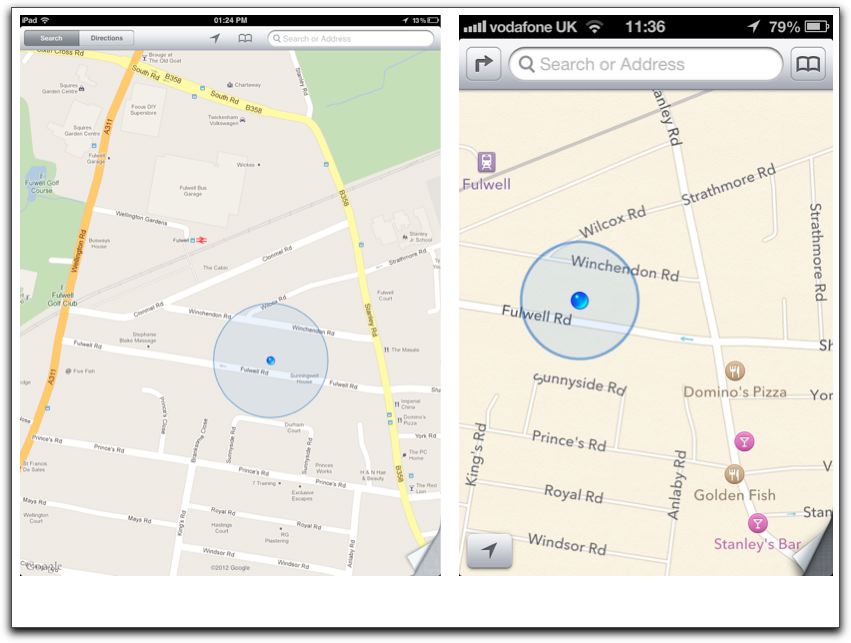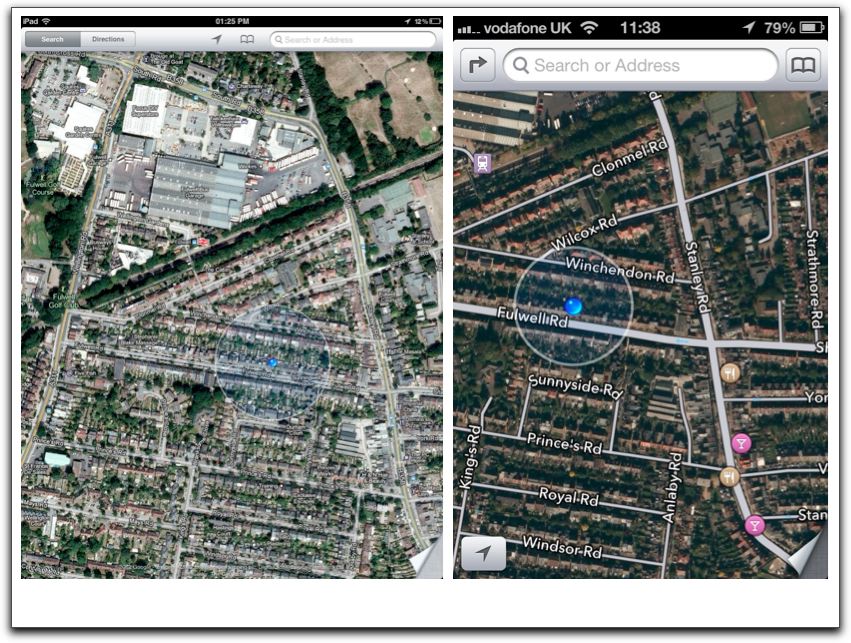Map Wars; Are Apple's Maps Really That Bad?
Making a map isn't easy. Making a map of streets and land features is hard. Making a map of streets and land features that stays up to date is harder. Making a map of streets, features and places, businesses, services, points of interest is harder still. Making a map of all of the previous that stays up to date is really hard. Making a map with all of the previous, wrapping it up in an app that runs on your smartphone and making it useable is verging on insanely difficult. Yet that's what Google and Nokia have been doing and with the release of iOS 6, that's what Apple is now doing as well. So how is Apple doing?
To make a map you need several things. Firstly you need spatial data for the streets and land features. You can either license this data globally from TomTom (TeleAtlas), from Nokia (NAVTEQ) or from OpenStreetMap or you can stitch together data from local and national sources, such as the UK's Ordnance Survey, and come up with a modicum of a global map. Yes I know that Google now have their own maps, a by product of Google StreetView, but this isn't global, at least not yet and even Google license map data from TomTom.
Secondly you need non-spatial data. Places, businesses, services, points of interest and the like. Most people license this sort of data from a variety of sources, ranging from the more traditional Yellow Pages companies through to internet data providers such as Factual.
Thirdly, you need satellite imagery. Again, you typically license this from specialist imagery providers such DigitalGlobe.
Fourthly and just as importantly, you need time and you need money. All of this data costs; it's very expensive, labour intensive and time consuming to put together. You also need to take all of this data, which comes in whole plethora of different forms and make it work nicely together; this is also expensive, labour intensive and time consuming.
Wrap all of this data together in a smartphone app and you should have a working maps app that consumers will find easy to use and which gives them the answers to the questions they typically ask of a map. Back to my original question then, how is Apple doing? The polite answer would have to be ... not that well.
Let's start with a nit-picking point. The app icons from Google and from Apple. Both icons are centred around Infinite Loop, Apple's HQ in Cupertino, California with the 280 interstate going from East to West and North De Anza Boulevard running from North to South. Maybe it's just me, but the Apple Maps icon on the right, seems to advocate that you enter the 280 by driving straight off of a bridge carrying N De Anza over the freeway, which does seem a little risky and foolhardy.
But nit picking aside, how does Google and Apple square up and compare. To do this I used my iPhone 4, recently upgraded to iOS 6 alongside my second generation iPad, still running iOS 5 and still with Google Maps as Google hasn't, yet, released an iOS version of its maps app. I compared three areas I know pretty well. My local neighbourhood in Teddington, South West London, the area of Berlin around the Nokia offices and an area just to the South West of Campbell in California where some close friends live.
Let's start with Teddington. I'm going to leave out the discussion about the look and feel of the spatial map as this is both subjective and a matter of personal taste. Some people like Google's map style, some don't. So I'll just skip right over that topic.
At first glance, all the usual suspects are there. Roads, public transport, green spaces and a smattering of POIs, at least at this zoom level. To be fair, neither Google nor Apple get it completely right. There's a restaurant which closed down and reopened a few months back under a different name which, given the challenge around keeping data fresh can be forgiven. But Apple seems to also have places which don't exist, at least they haven't existed in the 10 plus years I've been living in this neighbourhood.
Switching to the hybrid, map plus satellite imagery, view and Apple seems to be ahead, but this is more a case of differing zoom levels between iPhone and iPad to try and get screenshots that can at least be compared side to side. Both sets of imagery seem relatively fresh, albeit taken at different times of the year.
Overall, both Google and Apple are pretty lacking in the suburbs of London so next I tried a more metropolitan area surrounding Nokia's office in the central Mitte district of Berlin.
Here both Google and Apple score higher for the amount of POIs on the map and for freshness and accuracy, although Google's 3D-a-like building outlines still show the old Nokia office with a large car park on the south side of Invalidenstraße, rather than the new office building which is there now.
This lack of freshness on the part of buildings is even more apparent on the hybrid view, showing the state of Nokia's office construction some 9 or so months ago, again with different imagery between Google and Apple.
Finally, over to California and not that many miles away from Apple's HQ in Cupertino. Here I'd really expect Apple's maps to shine, but sadly they don't. Although again, to be fair, this is also not that far away from Google's HQ in Mountain View, and neither Google nor Apple shine here, it's more a case of who shines less.
One thing that my screenshots don't show is the ease of use. How simple and accurate are these maps to use to find a given street address, postal code or POI. Given that I've already found Apple lacking in overall POI numbers it comes as no surprise that searching for a set of local POIs is disappointing on Apple's map. Both maps find streets pretty well in all three locations, though Apple seems to have problems with street numbers, especially those which contain number ranges, such as 18-24 High Street. Apple also falls down on postal code searches, which is surprising in the UK given that both companies license the Royal Mail's Postal Address File via the Ordnance Survey.
Back again to my original question ... how is Apple doing? When you're launching a competing product which is meant to go head-to-head with existing competitors you need to ensure that you launch something which is at least as good as your competitors, if not better. When you're launching a competing product which effectively removes the competitors from the public's sight, as iOS 6 did with Google Maps, then you need to be better than your competitor. Does Apple succeed in this? No and not by a long margin. You could argue that the maps from Apple and the maps from Google are just about on a par in terms of content in central metropolitan areas, but out in the suburbs, where a lot of people live, Apple doesn't even come close. Yet.
That's a key word in all of this debate of Apple vs. Google ... yet. Apple have only just launched their maps and haven't yet had time to put in place all of the data relationships that Google's maps rely on. Comparing the legal notices for Google's maps with those for Apple's maps - shows just how much Apple have to catch up on. I'll leave it as an exercise to the reader to count how many relationships Google has compared with Apple.
As Charles Arthur pointed out in The Guardian recently, Apple is no stranger to launches and products going wrong. In time, Apple will correct the glaring omissions and errors in its maps and will build up a critical mass of data relationships to be able to go head-to-head with other maps apps on a basis of quantity and quality of data, but right now Apple is using their control over iOS to replace Google's maps with a sub-par experience. As I mentioned right at the start of this post, making a map is hard and it takes time and it takes money. Apple have the luxury of both. Time will also tell whether Google does launch the rumoured iOS 6 Google Maps app or whether Apple will reject this due to competing functionality with iOS; somehow I doubt they will do this due to the inevitable bad publicity this will undoubtedly generate. But even if Google do launch Maps for iOS6; I cannot help but wonder how many people will jump back to Google maps in favour of Apple's map, in just the same way that Internet Explorer still enjoys a large installed user base simply because it's on people's PCs when they switch it on for the first time.




